七年级英语上册《Unit2I'dlikesomenoodlesperiod1》教案鲁教版五四制
- 格式:doc
- 大小:47.00 KB
- 文档页数:3

鲁教版七年级英语上册Unit2Idlikesomenoodles单元备课教案《Unit 2 I'd like some noodles》教材分析The topic of this unit is about food. The students will learn how to order food o r take-away. In this unit, the students will be able to use “would like” to express their need for food and learn how to ask other s’ information and provide their personal information during the process.教学目标1、知识目标:a. To master how to order food or take-away;b. To master the mod a l verb “would” and “what” questions.c. To master the usage of countable nouns and uncountable nouns.2、技能目标:a. To use “would like” to talk about the need for food.b. To improve students’ ability of communication and social practice.3、情感态度价值观目标:Let the students experience the happiness of learning English, cultivate their ability to do things and foster the spirit of cooperationin group activities.教学重点(1)Key words and target language and structures;(2)To master the usage of countable nouns and uncountable nouns;教学难点To use “would like” to express their need for food and learn how to order food.教学方法active cooperation,study by using what you know and inferring content学生情况分析Food is the topic of the students like to talking about, the stued nts like to eat noodles, button,or tomatoes and so on.They also like learning the new words or the way to order the food.单元学科知识体系构建Vocabularylarge, noodles, beef, chicken, mutton, potatoes, cabbage, dumplings, porridge, soup, green tea, orange juice, would like, address, kind, size, bowl.Sentences:(1) What kind of noodles would you like?I’d like beef and tomato noodles, please. (2) What size bowl of noodles would you like? I’d like a large / medium / small bowl of noodles.课时分配Period One: Section A 1a--------1cPeriod Two: Section A 2a--------grammmar focusPeriod Thre e: Section A 3a--------3dPeriod Four: Section B 1a--------1ePeriod Five: Section B 2a--------2ePeriod Six: Section B 3a------4 Period Seven: self check。
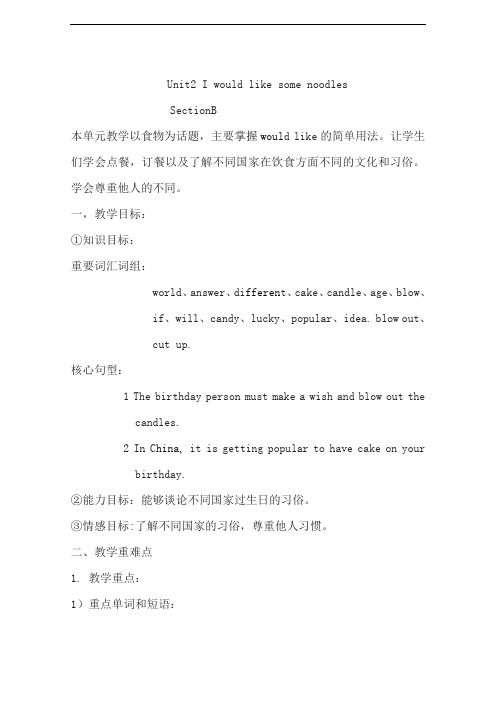
Unit2 I would like some noodlesSectionB本单元教学以食物为话题,主要掌握woul d like的简单用法。
让学生们学会点餐,订餐以及了解不同国家在饮食方面不同的文化和习俗。
学会尊重他人的不同。
一,教学目标:①知识目标:重要词汇词组:world、answer、di fferen t、cake、candle、age、blow、if、will、candy、lucky、popular、idea. blow out、cut up.核心句型:1 The birthday person must make a wish and blow out thecandles.2 In C hina, it is getting popular to have cake on yourbirthday.②能力目标:能够谈论不同国家过生日的习俗。
③情感目标:了解不同国家的习俗,尊重他人习惯。
二、教学重难点1. 教学重点:1)重点单词和短语:world、answer、different、cake、candle、age、blow、if、will、candy、lucky、popular、idea. blow out、cut up.2)句型:1,The birthd ay person must make a wish and blow out the candles.2, In China, it is getting popular to have cakeon your birthday.2. 教学难点:1)would like 的用法。
2)a number of与 the number of的用法区别。
三,教学过程Step 1 Teaching AimsShow the teaching aims of this class , read together①知识目标:重要词汇词组:world、answer、differ ent、cake、candle、age、blow、if、will、candy、lucky、popular、idea. blow out、cut up.核心句型:1 The birthday person must make a wish and blow out thecandles.2 In China, it is getting popular to have cakeon your birthday.②能力目标:能够谈论不同国家过生日的习俗。
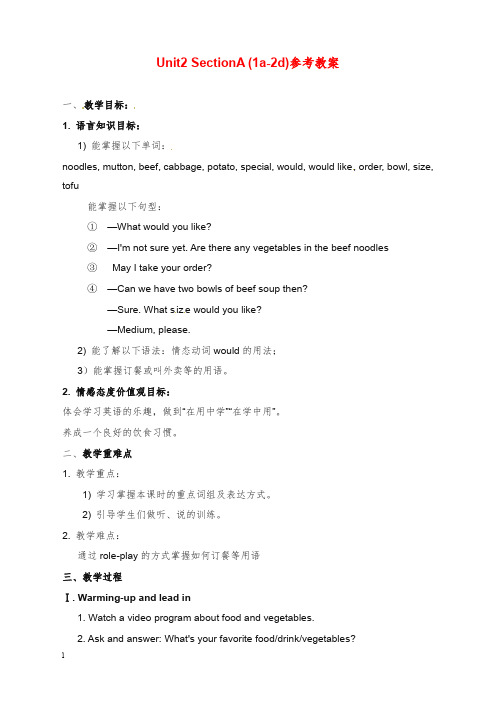
Unit2 SectionA (1a-2d)参考教案一、教学目标:1. 语言知识目标:1) 能掌握以下单词:noodles, mutton, beef, cabbage, potato, special, would, would like, order, bowl, size, tofu能掌握以下句型:①—What would you like?②—I'm not sure yet. Are there any vegetables in the beef noodles③May I take your order?④—Can we have two bowls of beef soup then?—Sure. What s iz e would you like?—Medium, please.2) 能了解以下语法:情态动词would的用法;3)能掌握订餐或叫外卖等的用语。
2. 情感态度价值观目标:体会学习英语的乐趣,做到“在用中学”“在学中用”。
养成一个良好的饮食习惯。
二、教学重难点1. 教学重点:1) 学习掌握本课时的重点词组及表达方式。
2) 引导学生们做听、说的训练。
2. 教学难点:通过role-play的方式掌握如何订餐等用语三、教学过程Ⅰ. Warming-up and lead in1. Watch a video program about food and vegetables.2. Ask and answer: What's your favorite food/drink/vegetables?Ⅱ. Presentation1. (show some pictures of food on the big screen)Present some new words and expressions to the Ss.2. Ss learn the new words and expressions by themselves and try to remember them.3. Work on 1a:Read the words on the left and look at the pictures on the right. Write the letters of the food on the line. Then check the answers.Ⅲ. Game (Guess the food.)(Show some pictures of food on the big screen)[来Let Ss guess what food it is.Ss try to guess the food and learn the words.Ⅳ. ListeningT: In the foll owing conversation, one man is ordering some food. Now, let’s listen to the tape, find out the right n oodles the person orders.Play the recording for the Ss to listen a nd check the answers.Ⅴ. Pair work1. Present the conversation in 1b on the big screen and ask Ss to practice it.2. Make thei r own conversations using the noodles in the picture3. Let some pairs act out their conversations.Ⅵ. Listening1. Work on 2a;T: Now, look at the pictures on the right, listen to the conversations an d check the names of the foods you hear.(Play the recording for the first time, students only lis ten carefullyThen, listen to the recording again, and check the names of the foods.Check the answers. )2. Work on 2b:(Play the recording for the Ss to lis ten and complete the se ntences.)Play the recording twice. The first time Ss just listen. And the second time, Ss listen and write down the words.(If necessary, use the pause button to help Ss)3. Chec k the answersⅦ. Pair work1. Ask and answer questions with your p artner. Use the information in 2a.2. Show the conversations of 2a on the big screen to the Ss.3. Make a model for the Ss.T: What kind of noodles would yo u like?[S1: I'd like beef noodles, please.…3. Ss work in pairs and practice the conversations.Ⅷ. Role-play1. Ask Ss to read the conversation in 2d and find the answer to this question:What would they like?(They would like one large bowl of beef soup, one gongbao chicken, and one mapo tofu with rice.)2. Check the answers with the Ss.3. Ss work with their partners and role-play the conversation.VIII. Language pointsIX. ExercisesHomework1. Review the words and e xpressions in this period.2. Role-play the conversation in 2d3. Write a short conversation to order some noodles you like in a restaurant.板书设计:。
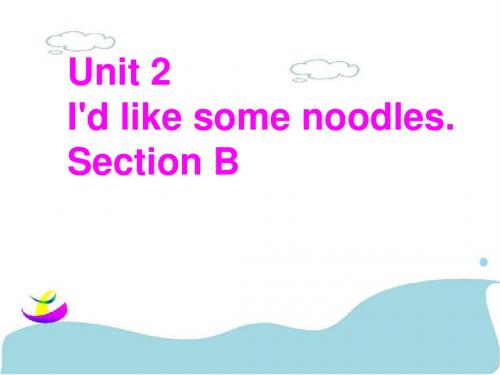
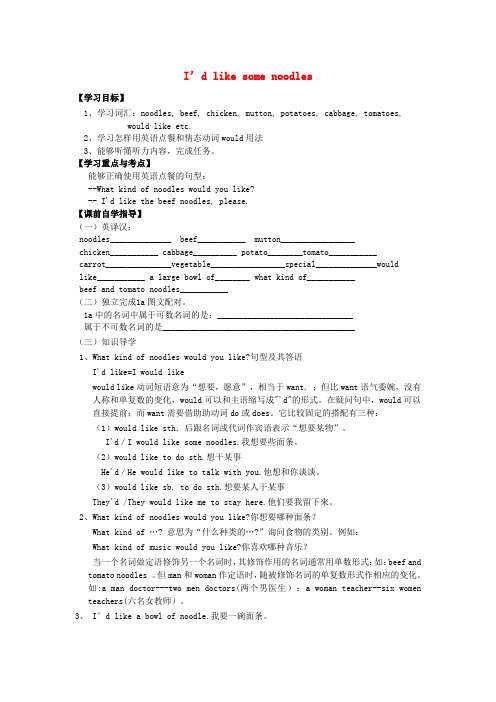
I’d like some noodles【学习目标】1、学习词汇:noodles, beef, chicken, mutton, potatoes, cabbage, tomatoes,would like etc.2、学习怎样用英语点餐和情态动词would用法3、能够听懂听力内容,完成任务。
【学习重点与考点】能够正确使用英语点餐的句型:--What kind of noodles would you like?-- I'd like the beef noodles, please.【课前自学指导】(一)英译汉:noodles______________ beef___________ mutton_________________chicken___________ cabbage__________ potato________tomato___________carrot_______________vegetable_________________special______________wouldlike___________ a large bowl of________ what kind of___________ beef and tomato noodles___________(二)独立完成1a图文配对。
1a中的名词中属于可数名词的是:_______________________________属于不可数名词的是____________________________________________(三)知识导学1、What kind of noodles would you like?句型及其答语I'd like=I would likewould like动词短语意为“想要,愿意”,相当于want, ;但比want语气委婉,没有人称和单复数的变化,would可以和主语缩写成"'d"的形式。
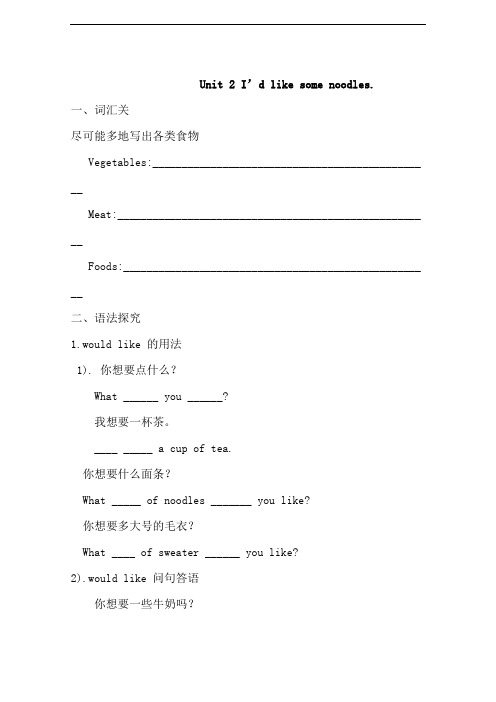
Unit 2 I’d like some noodles.一、词汇关尽可能多地写出各类食物Vegetables:______________________________________________ __Meat:____________________________________________________ __Foods:___________________________________________________ __二、语法探究1.would like 的用法1). 你想要点什么?What ______ you ______?我想要一杯茶。
____ _____ a cup of tea.你想要什么面条?What _____ of noodles _______ you like?你想要多大号的毛衣?What ____ of sweater ______ you like?2).would like 问句答语你想要一些牛奶吗?______ you _____ some milk?是的,谢谢。
/ 不,谢谢。
____, _______. / ___, _______.你愿意和我们一起去划船吗?______ you ____ to ____ boating with us?__________________, but I have a lot of homework to do.2、可数名词与不可数名词1. 可数名词:可数名词有单数、复数之分。
其复数形式一般要加-s或-es。
如:potato — _________; tomato — __________2. 不可数名词没有复数形式,只有单数形式。
如:some ______ (米饭); a lot of _____ (牛肉)(1)不可数名词数量多少的表示两玻璃杯果汁 _____ ________ of juice三碗米饭 _______ ______ of rice(2) 不可数名词做主语时,谓语动词只能用_________数形式。
《Unit 2 I'd like some noodles Period 1》课题Unit 2 I'd like some noodles. Period 1课型New教学目标1、知识目标:通过听说训练掌握下列单词和句型:1)noodles, beef, mutton, chicken, cabbage, potatoes, tomatoes.2)Target Language:Hello.I’d like some noodles.What kind of noodle s would you like?I’d like beef and tomato noodles, please.2、技能目标:能听懂主要信息,并能根据谈话记录正确信息3、情感态度价值观目标:Try to keep healthy diet.教学重点1. To learn the names of food and the countable and uncountable nouns;2. To make pair work.教学难点To learn how to order food;学情分析Food is the topic of the students like to talking about, the stuednts like to eat noodles, button,or tomatoes and so on.They also like learning the new words or the way to order the food.教学准备Recorder. Multi—medium computer集体备课个人备课Step One: Show the preview works (text-books andnote-paper).Teacher : 1. Draw a check table on the blackboard.2. Listen to the report from the winners. Try tofind out how the students preview, and sum up .3. Show the aims for students to choose.(At t he same time, students step into the second stepslowly, some by some.)Step Two: Learn by themselves.Students: 1. Decide my own aims.2. Self-study:1) correct their wrong answers2)1a 中的单词和对话3)Group-study: Talk about their problems.Step Three: Talk about the problems with the teacher together.would like sth.意思____________..e.g. 我想要些牛肉___________would like to do sth 意思____________..e.g. 我想要吃些牛肉_________________________would like sb to do sth 意思____________..e.g. 我想我的朋友们要吃些牛肉。
鲁教版英语七上Unit 2 I’d like some noodles Section A 教学设计3一. 教材分析鲁教版英语七上Unit 2 I’d like some noodles Section A 主要讲述了日常生活中的一些食品和饮料的名称及表达方式。
本节课通过一个关于餐厅的场景,让学生掌握一些基本的食品和饮料的英语表达,并能够运用所学知识进行简单的交流。
本节课的主要句型是“I’d like some…”,意为“我想要一些……”。
教材内容贴近学生生活,有利于激发学生的学习兴趣和积极性。
二. 学情分析学生在进入七年级之前,已经掌握了一定的英语基础知识,能够进行简单的英语交流。
但部分学生对英语的学习兴趣不高,学习积极性有待提高。
此外,学生在本节课的内容上可能存在一定的困难,因为涉及到一些生活中不常见的食品和饮料的英语表达。
因此,教师在教学过程中应注重激发学生的学习兴趣,调动学生的学习积极性,并通过有效的教学方法帮助学生掌握知识点。
三. 教学目标1.知识目标:让学生掌握一些基本的食品和饮料的英语表达,并能够运用所学知识进行简单的交流。
2.能力目标:培养学生的英语听、说、读、写能力,提高学生的英语综合素质。
3.情感目标:激发学生对英语学习的兴趣,调动学生的学习积极性,培养学生的合作意识。
四. 教学重难点1.重点:让学生掌握句型“I’d like some…”及其应用。
2.难点:学生对一些生活中不常见的食品和饮料的英语表达的掌握。
五. 教学方法1.情境教学法:通过设置餐厅的场景,让学生在真实的情境中学习并运用所学知识。
2.交际法:引导学生进行角色扮演,进行实际的英语交流,提高学生的口语表达能力。
3.游戏教学法:通过设计相关的游戏活动,激发学生的学习兴趣,巩固所学知识。
六. 教学准备1.教材:鲁教版英语七上U nit 2 I’d like some noodles Section A2.课件:根据教学内容设计的课件3.教学道具:一些食品和饮料的实物或图片4.录音机、音响等音响设备七. 教学过程1.导入(5分钟)教师通过向学生展示一些食品和饮料的实物或图片,引导学生进行观察,激发学生的学习兴趣。
Unit2 SectionB (1a-2e)参考教案一、教学目标:1. 语言知识目标:1) 能掌握以下单词:dumpling, porridge, onion, fish, pancake, world,answer, different, candle, age, blow, candy,lucky,popular, cut up2) 能掌握以下句型:① The answer would be d ifferent in different countries.② The number of candles is the person's age.③ In China, it's getting popular2. 情感态度价值观目标了解世界各地的饮食文化,生日文化等事情,使学生们具有初步的世界文化观念二、教学重难点1. 教学重点:1) 通过进行听、说的训练,来提高学生们综合运用所学知识的能力。
2) 通过读、写的训练,来让学生们能真正在实际活动中运用所学的知识。
2. 教学难点听力训练与阅读训练三、教学过程Ⅰ. Warming- upLet’s watch a video and learn.Ⅱ. Presentation1. (show some pictures of food on the big screen)Present some new words and expressions to the Ss.2. Ss learn the new words and exp ressions by themselves and try toremember them.3. Work on 1aRead the words in the ch art and look at the pictures below. Writethe letters of the foods or drinks on the line. Then check theanswers.4. Let Ss try to remember the new words and expressions.Ⅲ. Pairwork1. Circle the things you like in 1a. Put an х n ext to the things youdon’t like Then tell you partner what you like and don't like.Sa I like dumplings, but I don't like noodles.Sb Well, I like fish but I don't like meat.2. Work in groups. Talk about what you like and what you don’t like.3. Make a list of things every one likes and dislikes in your group.Then give a report to your classmatesIn our group, Sa likes dumplings but she doesn't like noodles. Sblikes fish but she doesn't like meat. …4. Let some Ss give their report.Ⅳ. ListeningWork on 1c1. Ask Ss to read the ORDER FORM c arefully.2. Play the tape for the Ss to listen and plete the food order f orm.(Play the recording for the first time, students only listen carefullyThen, listen to the reco rding again, and write down the names ofthe foods. )Work on 1dListen again. Check the answers with the SsⅤ. Group wor k1. Work in groups. Discuss what do you do or eat on your birthday?2. Ss take turns to talk about it.S1 I usually get many nice gifts from my parents. I usua lly havea nice dinner in a restaurant.S2 My parents usually buy me some nice books and school things on my birthday.S3 ….3. Write down what your group members do on their birthday. And givea report to the class.In my grou p, S1… S2… S3…Ⅵ. Presentation1. (show some pictu res of the new words in the passage on the big screen)Present some new words and expressions to the Ss.2. Ss learn the new words and expressions by themselves and try to remember them.Ⅶ. Reading1. Fast readingTrue or False2. Careful readingRead th e passage plete the chart in 2e.阅读指导:首先,读表格,记住这四空格,分别是在美国及中国人们在过生日时所吃的食物及他们的特殊含义。
Unit 2 I’d like some noodles Section A教学设计一.教材分析:本节课选自山东教育出版社七年级上册Unit2 I’d like some noodles.第一课时,本单元围绕着订餐这一核心话题展开,要求学生能够运用would like 来表达自己对食物的需求,从而学会订餐,并且在学习中培养学生的人际交往能力,倡导学生在日常生活中健康饮食,合理膳食。
二.教学方法:任务型教学法,小组合作学习法,多媒体辅助教学法。
三.教学目标:1、掌握新单词: noodles, beef, mutton, chicken, cabbage, potatoes, tomatoes, large,medium, small.并进一步区分已经学过的可数和不可数名词。
2、学会would like构成的疑问句及回答,并能够使用该语言进行交际对话。
3、在学习表达点菜﹑订餐和购物等活动中培养合作的能力,在运用目标语言进行交流的过程中,引导学生注意以前学过的礼貌用语。
4、引导学生体会健康饮食,要爱生活,爱父母。
四.教学重、难点:1、重点:学习日常生活中有关的食物名称的单词;学会would like句型的特殊疑问句及其回答。
2、难点: 感悟两个疑问句的相同点和不同点;灵活应用新句型模拟生活场景进行点菜、订餐、购物等对话五.教学过程:Step1. Warm-upT: Good morning! Boys and girls. I’m very glad to see you here. Nice to meet you.What did you eat for breakfast ?S1: I ate an egg, two pieces of bread and some porridge.S2: I ate…【设计意图】通过师生问答今天所吃的食物进行自由交际,为学习本课时的内容做好铺垫。
Step2. Lead-in呈现有关食物的图片,引出课题,展示学习目标Step3. Present the new words.教师通过多媒体依次向学生呈现本课时要学的食物图片,让学生在小组内活动,并用汉语或英语说出图片所代表的食物名称,教师可采取play a guessing game的方式来调动学生的学习积极性。